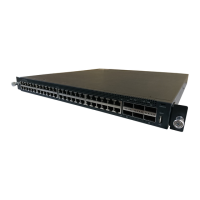User’s Guide FUJITSU PSWITCH
December/2018 71
for each instance. One common and internal spanning tree (CIST) Regional Root for
the CIST and an MSTI Regional Root Bridge per instance will enable the possibility
of alternate paths through each Region. Above Switch A is elected as both the MSTI
1 Regional Root and the CIST Regional Root Bridge, and after adjusting the Bridge
Priority on Switch C in MSTI 2, it would be elected as the MSTI 2 Regional Root.
To further illustrate the full connectivity in an MSTP active topology, the following
rules apply:
1. Each Bridge or LAN is in only one Region.
2. Every frame is associated with only one VID.
3. Frames are allocated either to the IST or MSTI within any given Region.
4. The internal spanning tree (IST) and each MSTI provides full and simple
connectivity between all LANs and Bridges in a Region.
5. All Bridges within a Region reach a consistent agreement as to which ports
interconnect that Region to a different Region and label those as Boundary
Ports.
6. At the Boundary Ports, frames allocated to the CIST or MSTIs are forwarded or
not forwarded alike.
7. The CIST provides full and simple connectivity between all LANs and Bridges in
the network.
3.1.2.8.5. Classic STP, Multiple STP, and Rapid STP
Classic STP provides a single path between end stations, avoiding and eliminating
loops. Multiple Spanning Tree Protocol(MSTP) is specified in IEEE 802.1s and
supports multiple instances of Spanning Tree to efficiently channel VLAN traffic
over different interfaces. Each instance of the Spanning Tree behaves in the
manner specified in IEEE 802.1w, Rapid Spanning Tree (RSTP), with slight
modifications in the working but not the end effect (chief among the effects, is the
rapid transitioning of the port to Forwarding).
The difference between the RSTP and the traditional STP (IEEE 802.1D) is the
ability to configure and recognize full-duplex connectivity and ports which are
connected to end stations, resulting in rapid transitioning of the port to the
Forwarding state and the suppression of Topology Change Notifications.
MSTP is compatible to both RSTP and STP. It behaves appropriately to STP and RSTP
bridges. A MSTP bridge can be configured to behave entirely as a RSTP bridge or a
STP bridge.

